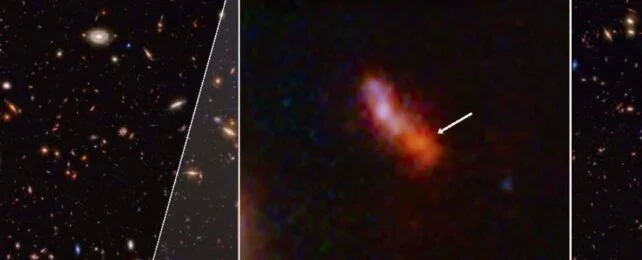
JWST Shatters Records: Unveils Most Distant Galaxy, MoM-z14, from the Dawn of the Universe
The James Webb Space Telescope (JWST) continues to redefine our understanding of the cosmos, achieving a groundbreaking feat by detecting the most distant galaxy ever observed: MoM-z14. This remarkable discovery pushes our observational horizon to just 280 million years after the Big Bang, a period when scientists previously believed little existed. This has left astronomers puzzled and eager to learn more about the origins of the universe we know today.
Before JWST, telescopes like Hubble and Spitzer faced limitations in peering this far back in time. Hubble's 2.4-meter mirror could only reach around 500 million years after the Big Bang, while Spitzer's smaller mirror lacked the necessary sensitivity. JWST's advanced infrared capabilities and massive mirror have now opened a window to observe light from galaxies existing within the first few hundred million years of cosmic history.

The newly discovered MoM-z14, boasts a redshift of z=14.44, surpassing the previous record holder, JADES-GS-z14-0, at z=14.32. According to a paper by Rohan Naidu and colleagues from the MIT Kavli Institute for Astrophysics and Space Research, JWST has unveiled “a stunning population of bright galaxies at surprisingly early epochs.” This finding has emerged from the Mirage spectroscopic survey, which aims to confirm candidate galaxies that exist at extreme redshifts.
What makes MoM-z14 particularly intriguing is that most of its light originates from stars rather than an active galactic nucleus (AGN) powered by a supermassive black hole. This suggests that MoM-z14 may harbor supermassive stars, long theorized to exist in the universe’s earliest stellar nurseries. Furthermore exciting similarities appear between MoM-z14 and ancient globular clusters, indicating a shared evolutionary lineage.

Interestingly, data reveals two primary types of ancient bright galaxies: point source and extended. Morphology, it seems, directly correlates with chemical patterns: compact sources often exhibit strong nitrogen emissions, while extended sources do not. MoM-z14, landing squarely into the nitrogen-enhanced compact galaxies segment, adds depth to the evolving understanding of galactic phenomena.
JWST’s observation goes beyond simply identifying early galaxies; it unveils links between early galaxies and known structure in the local universe. This provides insight through what some call galactic archaeology. The nitrogen enrichment, brightness, ionizing radiation, and morphology of MoM-z14 all point toward an environment where runaway stellar collisions may produce extraordinary supermassive stars.
Previously, researchers had only been able to assume what the early building blocks of our current cosmos looked like.
Of course, with this new knowledge also comes puzzles that will drive future studies of this topic for years to come. One key discovery by JWST centers around what has been referred to as “little red dot” galaxies. Galaxy MoM-z14 is considered one of these ultra-distant JWST galaxies. And researchers suggest that there are major variances between these early galaxies and modern galaxies due to an unexpectedly high rate of ionization.

As the paper concludes, the JWST appears “poised to drive a series of great expansions of the cosmic frontier,” inching ever closer to the era of the very first stars. With upcoming instruments like the Nancy Grace Roman Space Telescope promising even broader and deeper sky surveys, we are only just getting started.
What does this groundbreaking discovery mean for our understanding of the universe's origins? Does the existence of MoM-z14 challenge current cosmological models? Share your thoughts and theories in the comments below!